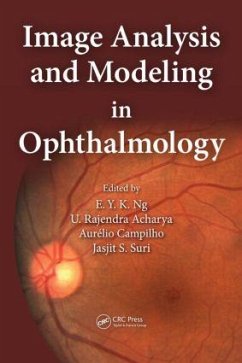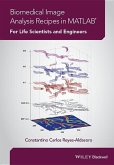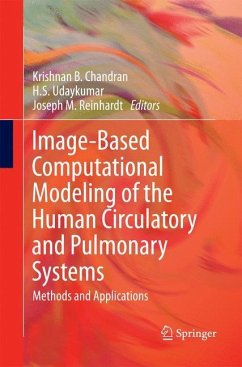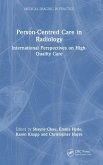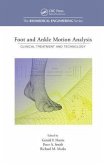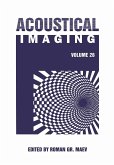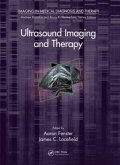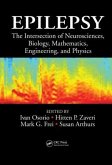Image Analysis and Modeling in Ophthalmology
Herausgeber: Ng, Eddie Y K; Campilho, Aurelio; Suri, Jasjit S; Acharya, U Rajendra
Image Analysis and Modeling in Ophthalmology
Herausgeber: Ng, Eddie Y K; Campilho, Aurelio; Suri, Jasjit S; Acharya, U Rajendra
- Gebundenes Buch
- Merkliste
- Auf die Merkliste
- Bewerten Bewerten
- Teilen
- Produkt teilen
- Produkterinnerung
- Produkterinnerung
Successful thermal modeling of the human eye helps in the early diagnosis of eye abnormalities such as inflammation, cataracts, diabetic retinopathy, and glaucoma-all leading causes of blindness. This book presents a unified work of eye imaging and modeling techniques that have been proposed and applied to ophthalmologic problems. It delves into various morphological, texture, higher order spectra, and wavelet transformation techniques used to extract important diagnostic features from images, which can then be analyzed by a data scientist for automated diagnosis.
Andere Kunden interessierten sich auch für
![Biomedical Image Analysis Recipes in MATLAB Biomedical Image Analysis Recipes in MATLAB]() Constantino Carlos Reyes-AldasoroBiomedical Image Analysis Recipes in MATLAB99,99 €
Constantino Carlos Reyes-AldasoroBiomedical Image Analysis Recipes in MATLAB99,99 €![Image-Based Computational Modeling of the Human Circulatory and Pulmonary Systems Image-Based Computational Modeling of the Human Circulatory and Pulmonary Systems]() Image-Based Computational Modeling of the Human Circulatory and Pulmonary Systems110,99 €
Image-Based Computational Modeling of the Human Circulatory and Pulmonary Systems110,99 €![Person-Centred Care in Radiology Person-Centred Care in Radiology]() Person-Centred Care in Radiology231,99 €
Person-Centred Care in Radiology231,99 €![Foot and Ankle Motion Analysis Foot and Ankle Motion Analysis]() Gerald F HarrisFoot and Ankle Motion Analysis342,99 €
Gerald F HarrisFoot and Ankle Motion Analysis342,99 €![Acoustical Imaging Acoustical Imaging]() Roman Gr. Maev (Hrsg.)Acoustical Imaging179,99 €
Roman Gr. Maev (Hrsg.)Acoustical Imaging179,99 €![Ultrasound Imaging and Therapy Ultrasound Imaging and Therapy]() Ultrasound Imaging and Therapy275,99 €
Ultrasound Imaging and Therapy275,99 €![Epilepsy Epilepsy]() Epilepsy368,99 €
Epilepsy368,99 €-
-
-
Successful thermal modeling of the human eye helps in the early diagnosis of eye abnormalities such as inflammation, cataracts, diabetic retinopathy, and glaucoma-all leading causes of blindness. This book presents a unified work of eye imaging and modeling techniques that have been proposed and applied to ophthalmologic problems. It delves into various morphological, texture, higher order spectra, and wavelet transformation techniques used to extract important diagnostic features from images, which can then be analyzed by a data scientist for automated diagnosis.
Produktdetails
- Produktdetails
- Verlag: CRC Press
- Seitenzahl: 412
- Erscheinungstermin: 11. Februar 2014
- Englisch
- Abmessung: 261mm x 184mm x 32mm
- Gewicht: 893g
- ISBN-13: 9781466559301
- ISBN-10: 1466559306
- Artikelnr.: 37050672
- Verlag: CRC Press
- Seitenzahl: 412
- Erscheinungstermin: 11. Februar 2014
- Englisch
- Abmessung: 261mm x 184mm x 32mm
- Gewicht: 893g
- ISBN-13: 9781466559301
- ISBN-10: 1466559306
- Artikelnr.: 37050672
E Y K Ng, received his PhD at Cambridge University. He is a faculty member at the Nanyang Technological University in the School of Mechanical and Aerospace Engineering. Ng is editor-in-chief for the J. of Mechanics in Medicine and Biology and J. Med. Imaging and Health Informatics; assoc. editor for Int. J. of Rotating Machinery, Computational Fluid Dynamics J., Int. J. of Breast Cancer, Chinese J. of Medicine, Open Medical Informatics J., Open Numerical Methods J., and J. of Healthcare Engineering; and strategy assoc. editor-in-chief for World J. of Clinical Oncology. Ng has published more than 255 SCI journal papers, and co-edited 11 books including Human Eye Imaging and Modeling by CRC (2011). U. Rajendra Acharya, PhD, DEng is a visiting faculty in Ngee Ann Polytechnic, Singapore. He is also an adjunct professor at the University of Malaya, Malaysia; adjunct faculty in Singapore Institute of Technology-University of Glasgow, Singapore; associate faculty in SIM University, Singapore; and adjunct faculty in Manipal Institute of Technology, Manipal, India. He received his Ph.D. from the National Institute of Technology Karnataka, Surathkal, India and D Engg from Chiba University, Japan. He has published more than 275 papers in refereed international SCI-IF journals, international conference proceedings, textbook chapters, and books. His major interests are in biomedical signal processing, bio-imaging, data mining, visualization, and biophysics. Aurélio Campilho, is a full professor in the Department of Electrical and Computer Engineering, Faculty of Engineering, University of Porto (FEUP), Portugal. He served as president of the Biomedical Engineering Institute, as director of the doctoral program in Electrical and Computer Engineering at FEUP, and as a member of the Scientific Committee of the Master Degree in Bioengineering at the University of Porto. His current research interests include the areas of medical image analysis, image processing, and computer vision. He served as associate editor of the journals IEEE Transactions on Biomedical Engineering and of the Machine Vision Applications journal. He authored one book, co-edited 12 books, and published more than 150 papers in journals and conferences. Jasjit S. Suri, MS, PhD, MBA, Fellow AIMBE, has spent over 25 years in the field of biomedical engineering/sciences and its management. He received his masters from University of Illinois, Chicago, doctorate from University of Washington, Seattle, and executive management education from Weatherhead School of Management, Case Western Reserve University, Cleveland. Dr. Suri has written over 350 peer-reviewed publications, and is a committee member of several journals and companies. Dr. Suri was crowned with the President's Gold medal in 1980 and the Fellow of American Institute of Medical and Biological Engineering (AIMBE), awarded by National Academy of Sciences, Washington DC in 2004.
Ultrasound Biomicroscopic Imaging of the Anterior Chamber Angle. Automated
Glaucoma Identification Using Retinal Fundus Images: A Hybrid Texture
Feature Extraction Paradigm. Ensemble Classification Applied to Retinal
Blood Vessel Segmentation: Theory and Implementation. Computer Vision
Algorithms Applied to Retinal Vessel Segmentation and Quantification of
Vessel Caliber. Segmentation of the Vascular Network of the Retina.
Automatic Analysis of the Microaneurysm Turnover in a Web-Based Framework
for Retinal Analysis. A-Levelset-Based Automatic Cup-to-Disc Ratio
Measurement for Glaucoma Diagnosis from Fundus Image. The Singapore Eye
Vessel Assessment System. Quantification of Diabetic Retinopathy Using
Digital Fundus Images. Diagnostics Instruments for Glaucoma Detection.
Automated Cup-to-Disc Ratio Estimation for Glaucoma Diagnosis in Retinal
Fundus Images. Arteriovenous Ratio Calculation Using Image-Processing
Techniques. Survey on Techniques Used in Iris Recognition Systems. Formal
Design and Development of an Anterior Segment Eye Disease Classification
System. Modeling of Laser-Induced Thermal Damage to the Retina and the
Cornea. Automatization of Dry Eye Syndrome Tests. Thermal Modeling of the
Ageing Eye. A Perspective Review on the Use of In Vivo Confocal Microscopy
in the Ocular Surface. Computational Modeling of Thermal Damage Induced by
Laser in a Choroidal Melanoma.
Glaucoma Identification Using Retinal Fundus Images: A Hybrid Texture
Feature Extraction Paradigm. Ensemble Classification Applied to Retinal
Blood Vessel Segmentation: Theory and Implementation. Computer Vision
Algorithms Applied to Retinal Vessel Segmentation and Quantification of
Vessel Caliber. Segmentation of the Vascular Network of the Retina.
Automatic Analysis of the Microaneurysm Turnover in a Web-Based Framework
for Retinal Analysis. A-Levelset-Based Automatic Cup-to-Disc Ratio
Measurement for Glaucoma Diagnosis from Fundus Image. The Singapore Eye
Vessel Assessment System. Quantification of Diabetic Retinopathy Using
Digital Fundus Images. Diagnostics Instruments for Glaucoma Detection.
Automated Cup-to-Disc Ratio Estimation for Glaucoma Diagnosis in Retinal
Fundus Images. Arteriovenous Ratio Calculation Using Image-Processing
Techniques. Survey on Techniques Used in Iris Recognition Systems. Formal
Design and Development of an Anterior Segment Eye Disease Classification
System. Modeling of Laser-Induced Thermal Damage to the Retina and the
Cornea. Automatization of Dry Eye Syndrome Tests. Thermal Modeling of the
Ageing Eye. A Perspective Review on the Use of In Vivo Confocal Microscopy
in the Ocular Surface. Computational Modeling of Thermal Damage Induced by
Laser in a Choroidal Melanoma.
Ultrasound Biomicroscopic Imaging of the Anterior Chamber Angle. Automated
Glaucoma Identification Using Retinal Fundus Images: A Hybrid Texture
Feature Extraction Paradigm. Ensemble Classification Applied to Retinal
Blood Vessel Segmentation: Theory and Implementation. Computer Vision
Algorithms Applied to Retinal Vessel Segmentation and Quantification of
Vessel Caliber. Segmentation of the Vascular Network of the Retina.
Automatic Analysis of the Microaneurysm Turnover in a Web-Based Framework
for Retinal Analysis. A-Levelset-Based Automatic Cup-to-Disc Ratio
Measurement for Glaucoma Diagnosis from Fundus Image. The Singapore Eye
Vessel Assessment System. Quantification of Diabetic Retinopathy Using
Digital Fundus Images. Diagnostics Instruments for Glaucoma Detection.
Automated Cup-to-Disc Ratio Estimation for Glaucoma Diagnosis in Retinal
Fundus Images. Arteriovenous Ratio Calculation Using Image-Processing
Techniques. Survey on Techniques Used in Iris Recognition Systems. Formal
Design and Development of an Anterior Segment Eye Disease Classification
System. Modeling of Laser-Induced Thermal Damage to the Retina and the
Cornea. Automatization of Dry Eye Syndrome Tests. Thermal Modeling of the
Ageing Eye. A Perspective Review on the Use of In Vivo Confocal Microscopy
in the Ocular Surface. Computational Modeling of Thermal Damage Induced by
Laser in a Choroidal Melanoma.
Glaucoma Identification Using Retinal Fundus Images: A Hybrid Texture
Feature Extraction Paradigm. Ensemble Classification Applied to Retinal
Blood Vessel Segmentation: Theory and Implementation. Computer Vision
Algorithms Applied to Retinal Vessel Segmentation and Quantification of
Vessel Caliber. Segmentation of the Vascular Network of the Retina.
Automatic Analysis of the Microaneurysm Turnover in a Web-Based Framework
for Retinal Analysis. A-Levelset-Based Automatic Cup-to-Disc Ratio
Measurement for Glaucoma Diagnosis from Fundus Image. The Singapore Eye
Vessel Assessment System. Quantification of Diabetic Retinopathy Using
Digital Fundus Images. Diagnostics Instruments for Glaucoma Detection.
Automated Cup-to-Disc Ratio Estimation for Glaucoma Diagnosis in Retinal
Fundus Images. Arteriovenous Ratio Calculation Using Image-Processing
Techniques. Survey on Techniques Used in Iris Recognition Systems. Formal
Design and Development of an Anterior Segment Eye Disease Classification
System. Modeling of Laser-Induced Thermal Damage to the Retina and the
Cornea. Automatization of Dry Eye Syndrome Tests. Thermal Modeling of the
Ageing Eye. A Perspective Review on the Use of In Vivo Confocal Microscopy
in the Ocular Surface. Computational Modeling of Thermal Damage Induced by
Laser in a Choroidal Melanoma.

